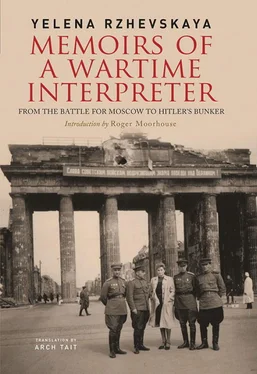The infantry marched by, holding up the traffic, the metal heel plates of their heavy boots clattering on the roadway. Their banner was being carried in its cover behind the unit’s commander.
Berliners stopped to read the commandant’s orders and note down the food ration.
We crossed a bridge over the Spree, skirting an upside-down German truck that had inscribed on its side, ‘All our wheels are turning for the war.’ A woman was sitting on the bridge, her head thrown back, her legs stretched out straight in front of her, laughing her head off. I greeted her. She looked at me with unfocused, transparent eyes, nodded back in greeting, as though recognizing me, and shouted out in a guttural, crazy, voice, ‘Alles kaput! ’
On 3 May 1945, a highly detailed report was compiled titled Certificate of identification of the German Reich Minister Dr Josef Goebbels, the wife of Goebbels, and of six children. More than ten people were involved in drawing up this document and signing it. These were people involved in the discovery, from the army’s reconnaissance section, from Smersh, the political section of the corps, the medical service, and the Germans who identified the bodies. The discovery of the bodies of Goebbels and his family was made very public, which seemed only natural. On that day nobody in charge thought differently. Journalists, photographers and newsreel reporters were allowed to record everything.
In the first days of victory, people experienced what they believed was a dawning of freedom. They acted rationally and normally, but found they had been deluding themselves. They were immediately pulled up. Stalin was outraged that people had taken the initiative to make this event so public and somebody evidently got a flea in his ear. From the following day a screen of strict secrecy went up round the search for Hitler. There was to be no contact with the press or photographers, and all reports were to go directly to Stalin, bypassing the Army command.
In the first edition of my book Berlin, May 1945, my conscience prompted me to warn the reader that when it was described in writing, the search for Hitler would inevitably be presented as going more smoothly than it did in reality. The purposeful development of my narrative, moving from fact to fact, was bound to give the impression of a more rational, orderly and down-to-earth process than was warranted.
At that time I titled one chapter ‘Without Mystification’, but in fact there was no shortage of mystification, and it was very much of our own, Soviet, making. The German part of the plot was the situation surrounding the death of Hitler, while the Soviet part of the plot was woven from the customary insistence on keeping everyone and everything completely in the dark.
It was an exaggeration I was obliged to make to suggest that we were carrying out a mission we had been set. The reader would, however, have found the reality just too implausible, because in fact no mission was ever formulated. Although, actually, I was not deviating too far from the truth, because there was a mission, the final mission of the war, and it was there to be felt in the very air of Berlin. Those who were conscious of it, the ‘grassroots’, took the initiative themselves.
Then and there, in the first days of May 1945, in difficult conditions and with no halfway trustworthy information to go by, the mission of leading the search for Hitler was assumed in our 3rd Shock Army by Colonel Vasiliy Gorbushin. There was a need to unify the efforts of the intelligence personnel, quickly get to the bottom of everything, cut through all the nonsensical rumours and complete the task.
The search was completed in a very short period, three days of incredibly intense, dedicated effort. The electricity supply was cut, which meant there was no telling where anything was and, as if that were not enough, there was the labyrinthine geography of the shelter to cope with. Our task was to make sense of the documents found there: the official and personal papers of Hitler, Bormann and others.
We had plenty of luck, but complications, sometimes absurd, were never far away. Let me tell you about one of them. In the Reich Chancellery garden there was a dried up pond where ornamental fish used to swim but in which, during the battle for Berlin, the bodies were dumped of those killed in the bombing and shelling, or shot in the garden on Hitler’s orders.
On 3 May a group of generals from the 1st Byelorussian Front headquarters were passing through the Chancellery garden. One or other of them decided one of the bodies looked like Hitler. It was immediately pulled out of the pond and Germans were called to identify it. Their unanimous verdict was, ‘Not the Führer.’
It was resolved, however, to await the arrival of a former member of staff of the Soviet embassy in Berlin who had seen Hitler before the war several times and was due to fly in from Moscow. Accordingly, a gentleman with a little moustache and his hair falling to one side of his face and wearing a pair of darned socks duly reposed for a considerable time in the vestibule of the Reich Chancellery, then in the hall, until the diplomat finally arrived and confirmed: ‘Not Hitler.’ Newsreel and photojournalists had meanwhile been having a field day photographing and filming the body and, proudly labelling it ‘Hitler’, later depositing their handiwork in the archive and the historical film library. No member of the press was allowed anywhere near the actual remains and they were not photographed.
Unsurprisingly, the false Hitler was later blithely spliced into a Soviet documentary film but, under pressure from an agitated foreign press, he was disavowed and the film withdrawn. The posthumous adventures of this unknown man did not end there, however. He spawned a whole constellation of ‘doubles’ whereas, in reality, Hitler never had any. Neither was the screen life of the false Hitler over. Thirty years after the ill-fated film he was again resurrected from the archive by journalists and the photo was shown on television, masquerading as the body of Hitler.
The falsehood was immediately exposed, not wholly without my involvement. For a day I was receiving phone calls from newspapers and television stations of various countries asking what they should make of the incident. A French television company urgently interviewed me in time for the evening news. The makers of the television programme responsible for all this nonsense hit back, saying on television that they had been misled by the archivists. That is how it ended that time. No doubt there will be a next time.
From the very outset, the decision to classify the discovery of Hitler’s body laid the foundation for all manner of speculation that continues to this day. No attempt was made to combat it by the simple expedient of telling the truth.
What Actually Happened?
Let us return to the Reich Chancellery while the search was in progress in May 1945, with that unidentified body reposing in the great hall. A unit of our army, 79th Corps, was leaving Berlin for a new deployment and a Smersh group who had already been involved in the search went with their commander, Lieutenant Colonel Klimenko, purely out of curiosity, to take a last look at the Chancellery garden and the place where Goebbels had been found. As Klimenko later wrote to me, that was near the emergency exit from Hitler’s bunker.
Now chance took a hand. Private Ivan Churakov’s attention was drawn to a bomb crater three metres or so to the left of that door. The soil in it was loose and seemed to have been thrown in recently. The soldier jumped down into the crater and, from the ground which had settled under his weight, something became visible. They dug down and found the black, charred bodies of a man and a woman. They pulled them out of the crater and took a good look at them. They did not recognize the man as Hitler, and indeed he was completely unrecognizable. The analogy with the charred body of Goebbels did not occur to them, and they did not look more closely at their find. The main thing that threw them off the scent was that Klimenko had heard Hitler’s body had already been found and was lying in the Reich Chancellery. That dead German in the darned socks hoodwinked them. The men filled in the crater again and left.
Читать дальше











